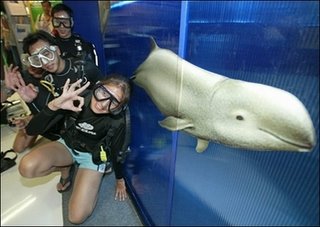 Thai diving operators pose next to a picture of an Irrawaddy dolphin in Bangkok, October 2004. At least 10 young Irrawaddy dolphins have been discovered in Cambodia, a government official has said, raising hopes the rare animal was being pulled back from the brink of extinction.(AFP/File/Pornchai Kittiwongsakul)
Thai diving operators pose next to a picture of an Irrawaddy dolphin in Bangkok, October 2004. At least 10 young Irrawaddy dolphins have been discovered in Cambodia, a government official has said, raising hopes the rare animal was being pulled back from the brink of extinction.(AFP/File/Pornchai Kittiwongsakul) Wed Oct 4, 2006
PHNOM PENH (AFP) - At least 10 young Irrawaddy dolphins have been discovered in Cambodia, a government official has said, raising hopes the rare animal was being pulled back from the brink of extinction.
The calves, observed by fisheries officials, were most likely born between May and July in the Mekong river not far from the Lao border, said Touch Seang Tana, who chairs a government commission established to protect the dolphins.
The commission was set up earlier this year after at least 12 dolphins died in January and February, raising extinction fears. Conservationists estimate that fewer than 100 Irrawaddy dolphins exist in the wild.
But Touch Seang Tana said that number could be around 130 and that he hoped there would be as many as 170 within the next five years.
He said since the beginning of the year, 66 guards had been posted along the river to protect the dolphins. Only two dolphins had been found dead since the commission was established, he said.
The government said the threats to the dolphins ranged from illegal fishing to habitat destruction.
Touch Seang Tana told AFP that starting next year, all fishing nets -- which are the primary cause of dolphin deaths -- will be banned along the stretch of Mekong from the central town of Kratie to the Lao-Cambodian border.
"We hope that, with these precautions, the dolphins will not become extinct," he said, adding that villagers have been educated about the value of the dolphins.
Thousands of the dolphins, which have blunt, round heads and are light, almost white in colour, once swam in the Mekong -- which flows from Tibet to the South China Sea and has tributaries in Cambodia, Laos and Vietnam.
The calves, observed by fisheries officials, were most likely born between May and July in the Mekong river not far from the Lao border, said Touch Seang Tana, who chairs a government commission established to protect the dolphins.
The commission was set up earlier this year after at least 12 dolphins died in January and February, raising extinction fears. Conservationists estimate that fewer than 100 Irrawaddy dolphins exist in the wild.
But Touch Seang Tana said that number could be around 130 and that he hoped there would be as many as 170 within the next five years.
He said since the beginning of the year, 66 guards had been posted along the river to protect the dolphins. Only two dolphins had been found dead since the commission was established, he said.
The government said the threats to the dolphins ranged from illegal fishing to habitat destruction.
Touch Seang Tana told AFP that starting next year, all fishing nets -- which are the primary cause of dolphin deaths -- will be banned along the stretch of Mekong from the central town of Kratie to the Lao-Cambodian border.
"We hope that, with these precautions, the dolphins will not become extinct," he said, adding that villagers have been educated about the value of the dolphins.
Thousands of the dolphins, which have blunt, round heads and are light, almost white in colour, once swam in the Mekong -- which flows from Tibet to the South China Sea and has tributaries in Cambodia, Laos and Vietnam.

























5 comments:
Great! My fellow patriots.
You did the right thing this time. I appreciate the Cambodian Government as the whole, and the officials of the Department of Fishery/Min. of Agriculture in particular for your intervention to protect our freshwater dolphins.
I have for a couple times visited the dolphin families in Kampi town of Kratie province. It is now becoming a famous spot of tourist attraction for both domestic and foreign tourists.
I wish Mr. Touch Seang Tana and his honorable team to keep doing their duties and succeed for the sake of our people and our belowed Cambodia.
Cheer!
A retired Khmer citizen.
THE SAME GOES WITH US!!!:)
THANK YOU & GOD BLESS!
. . . . but don't forget, the YUON OFFSPRINGS are multiply faster than that Irrawaddy dolphins.
Good night,
good news but more need to be done to protect and conserve what left of the past/current distruction of cambodia's natural resources.
Actually, the population is nearer to 70 dolphins, and declining rapidly. Touch Sean Tana is interested in boosting his reputation, and encouraging tourist investment from ADB, UNTO, and private organisations. This reported increase is both biologically impossible, and contrary to all scientific evidence collected by WWF international scientists.
See http://news.nationalgeographic.com/news/2007/03/070321-river-dolphin.html
for a more balanced report.
Post a Comment